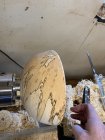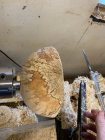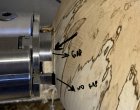To get the proper grip, the tenon needs to be sized and shaped to match the chuck jaws. Straight jaws need a straight tenon, angled (dovetailed) jaws need a dovetailed tenon.
The best hold happens where the jaws of the tenon make a circle, so they contact the tenon all the way round. Jaws are machined to a circle as one piece, then cut apart. Matching that circle (usually with something like 1/8" kerf/gap between the jaws) gives you the best grip.
But the thing that really gives you a good hold is the flats on the end of the tenon. When matched with a flat ring on the workpiece, it keeps the workpiece seated and centered, but more importantly it provides a surface to keep workpiece from levering off the chuck (IDK if levering is a word, but: lever as in with a crowbar).
The other important feature of a tenon is the corner between the tenon and the flat - if it's got a fillet then that's going to push the jaws away from the flat as you tighten them. If it's sharp then the jaws will sit nicely.
Get this geometry right and you shouldn't need to crank down on the chuck so much.

 I searched around for a way to prevent further spalting. Awhile back I came across some information but I can’t seem to find it. Does anyone have any experience with stopping the spalting from ruining a blank?
I searched around for a way to prevent further spalting. Awhile back I came across some information but I can’t seem to find it. Does anyone have any experience with stopping the spalting from ruining a blank?
